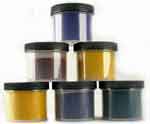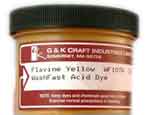Does longer cooking time in the dye bath mean better lightfast results?
Does longer cooking time in the dye bath mean better lightfast results?
Name: Lawanna
—ADVERTISEMENTS—

Lanaset Dyes are among the very best dyes for hand-dyeing wool, silk, angora, mohair, and most nylons. You will also need: citric acid, sodium acetate, Glauber salt, Albegal SET, and Synthrapol.
Buy from
Paradise Fibers
Washfast Acid dyes
at Paradise Fibers

Washfast Acid dyes
Also known as Nylomine dyes, excellent for use on wool or nylon. One ounce of dye will dye six pounds of fiber!
at Paradise Fibers

Washfast Acid dyes
Also known as Nylomine dyes, excellent for use on wool or nylon. One ounce of dye will dye six pounds of fiber!

Linda Knutson's book
Synthetic Dyes for Natural Fibers
includes information on lightfastness of some dyes
Country or region: USA
Message: I have a question about lightfastness and acid dyes. I dye wool for rug hooking. Does it matter how long you "cook" the wool in the dye bath? Does longer cooking time mean better lightfast results?
Inadequately fixed dye can be less lightfast than it would be if properly fixed. However, trying to fix your dye extra-well by cooking it longer than needed will not improve lightfastness.
Different dyes have dramatically different susceptibilities to light-fading. It matters a great deal exactly which dye colors, and from which brands, you choose. Some classes of dyes tend to be more light-resistant than others, as well; for example, most vat dyes are extremely light-resistant, while all basic dyes, when used on natural fibers such as wool, show extraordinarily poor lightfastness; some of these basic dyes are including among the little jars of dye that are pre-mixed for use in silk painting. The different dyes within a single group of dyes also vary quite a bit in their lightfastness. As a rule, however, all of the fluorescent dyes that you can find from any class of dyes (these are the dyes that seem to glow when ultraviolet light from a blacklight hits them), are highly prone to light-fading. Some food coloring dyes, including some of those found in Kool-aid, tend to be relatively poor in lightfastness.
Take a look at my page, "Lightfastness of Different Types of Dyes". (It's in the Frequently Asked Questions section of my website.) Read the material at the top, then scroll down to the section that lists some specific acid dyes, looking under the column "light", which lists manufacturers' information on lightfastness. The scale runs from 1 to 8, where 1 indicates that a dye is highly vulnerable to light damage, while 8 indicates that it resists damage due to light as well as any textile dye can be expected to.You will see that the leveling acid dye Acid Blue 7, which is sold by Jacquard Products among the Jacquard Acid Dyes as 624 Turquoise, and by PRO Chemical & Dye among their WashFast Acid Dyes as 478 Turquoise, has an extremely poor lightfastness rating of either 2 or 1, depending on which manufacturers' information you consult.
Many dyes, especially among those made for wool, are proprietary mixtures whose individual dyes are a trade secret, so that you cannot look them up. I recommend that, if you want to be able to look up information about your dyes, you give a preference to those whose identities are honestly shared by their sellers, such as ProChem's WashFast Acid Dyes or Jacquard Acid Dyes. You will not be able to look up lightfastness information from other sources if you use Landscape Acid Dyes or Cushing Acid Dyes or Rit All-Purpose Dyes. In some cases, you may be able to obtain lightfastness information from your supplier, if they are exceptionally responsible, but this is unlikely for most dye mixtures.
Alternatively, you can dye small swatches of fabric or bundles of yarn and do your own testing, by cutting your test samples in half and hiding one half of each sample in a box or drawer where they are protected from light, and exposing the other pieces to bright sunlight over the course of many days. It will become obvious which dyes are especially prone to fading. Some dyes are protected if screened from the sun by ultra-violet-protective glass, but many are damaged by visible light alone. Ultraviolet-protective sprays are often completely ineffective.
Below is some information extracted from my lightfastness page for some of the Washfast Acid Dyes. Keep in mind the interpretations of the numbers given for lightfastness ratings. A figure of 7-8 is excellent; 6 indicates very good lightfastness; 4-5 is fair; 2-3 is poor; and 1 is very poor. (Here's a link to a table with a more detailed explanation of what these numbers mean.)
Table I. Lightfastness ratings for Washfast Acid Dyes.
| Acid Yellow 7 | 107A Flavine Yellow G | 1-2 |
| Acid Yellow 19 | 119 Sun Yellow | 5 |
| Acid Red 138 | 338 Magenta | 4-5 |
| Acid Red 151 | 351 Bright Red | 4 |
| Acid Red 266 | 366 Red | 6 |
| Acid Red 52 | 370 Rhodamine Red B | 2-3 |
| Acid Red 131 | 390 Polar Red | 4-5 |
| Acid Blue 113 | 413 Navy | 5 |
| Acid Blue 25 | 425c National Blue | 5-6 |
| Acid Blue 40 | 440 Bright Blue | 6 |
| Acid Blue 7 | 478 Turquoise | 2 or 1 |
| Acid Blue 90 | 490 Brilliant Blue | 1-2 |
| Acid Violet 17 | 817 Brilliant Violet | 1 |
Unfortunately, I am lacking data for the following Washfast Acid Dyes, as well as all of the pre-mixed colors:
Table II. Washfast Acid Dyes whose generic names are known, but for which I lack lightfastness numbers.
| Acid Yellow 135 | 135 Yellow | ? |
| Acid Yellow 199 | 199c Golden Yellow | ? |
| Acid Orange 33 | 233 Bright Orange | ? |
| Acid Red 249 | 349 Fuchsia | ? |
| Acid Black 172 | 672 Jet Black | ? |
| Acid Green 25 | 725 Forest Green | ? |
Jacquard Products very helpfully makes lightfastness and washfastness information available for their Jacquard Acid Dyes, except for the premixed colors, on their website (on a scale of 1-7, they say, rather than the usual scale of 1 to 8, probably because of the fact that no acid dye has a lightfastness rating of 8):
Table III. Lightfastness ratings for Jacquard Acid Dyes.
| 601 Yellow Sun | Acid Yellow 49 | 5-6 |
| 602 Bright Yellow | Acid Yellow 19 | 5 |
| 603 Golden Yellow | Acid Yellow 219 | 7 |
| 604 Burnt Orange | Acid Orange 116 | 5-6 |
| 606 Deep Orange | ? | 7 |
| 610 Burgundy | Acid Red 299 | 5-6 |
| 614 Violet | Acid Violet 43 | 5-6 |
| 617 Cherry Red | Acid Red 266 | 6 |
| 620 Hot Fuchsia | Acid Red 52 | 2-3 |
| 621 Sky Blue | Acid Blue 129 | 4-5 |
| 622 Sapphire Blue | Acid Blue 25 | 4-5 |
| 623 Brilliant Blue | Acid Blue 62 | 4 |
| 624 Turquoise | Acid Blue 7 | 1 |
| 625 Royal Blue | Acid Blue 324 | 5-6 |
| 626 Navy Blue | Acid Blue 113 | 7 |
| 631 Teal Acid | Green 25 | 6 |
Clearly, if you are concerned about lightfastness (as every dyer should consider being), you will do better to choose ProChem's Sun Yellow instead of Flavine Yellow, ProChem's Red or Polar Red or Bright Red instead of Rhodamine Red, and Bright Blue or National Blue instead of ProChem's Turquoise or Brilliant Blue. Similarly, Jacquard's Sky Blue, Sapphire Blue, or Brilliant Blue are to be preferred to their Turquoise, and their Cherry Red to their Hot Fuchsia. Jacquard's Violet is far more light-resistant than ProChem's Brilliant Violet, and Jacquard's Golden Yellow is significantly more light-resistant than any of the yellows in the Washfast Acid Dye line, but some of the other colors in the ProChem line are better than some colors in the Jacquard line.
(Please help support this web site. Thank you.)
(Please help support this web site. Thank you.)
Posted: Thursday - September 01, 2011 at 08:06 AM
Follow this blog on twitter here.
Quick Links
- All About Dyes & Dyeing Top -
- Top of this blog -
- FAQ -
- The Dye Forum -
- How to Tie Dye - How to Batik -
- Books - Toys - Plants -
- Top of this blog -
- FAQ -
- The Dye Forum -
- How to Tie Dye - How to Batik -
- Books - Toys - Plants -
More in this category:
- -
Statistics
Total entries in this blog:
Total entries in this category:
Published On: Aug 29, 2012 02:49 PM
Total entries in this category:
Published On: Aug 29, 2012 02:49 PM